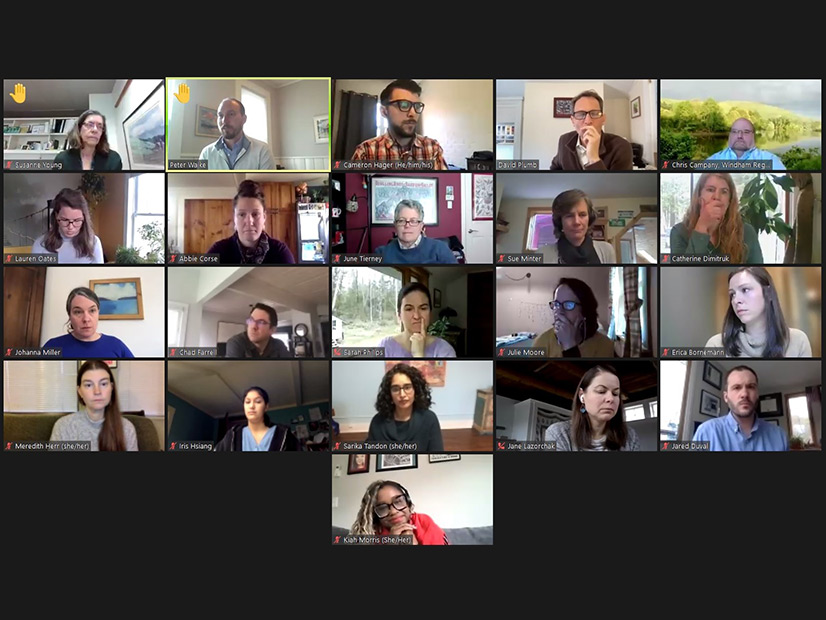The Vermont Climate Council is considering delaying the release of the Climate Action Plan that it is directed by statute to adopt this fall.
If the council interprets its statutory requirement “to produce a Climate Action Plan on Dec. 1 as producing a draft plan,” it could take a few more months to conduct additional public engagement, said David Plumb, senior mediator at the Consensus Building Institute.
It’s an idea that has been “floated around,” Plumb said during the council’s monthly meeting Monday.
The council previously proposed releasing a draft of the state’s first action plan by the beginning of October and holding a round of public engagement before adopting a final version in December, said Jane Lazorchak, land acquisition and stewardship coordinator at the Vermont Agency of Natural Resources (ANR). Delaying the release would enable another round of public engagement, she said.
Council members did not object to the suggested delay and left it for further consideration. There was, however, some concern about how that delay might affect the steps needed to build out the recommendations in the plan.
The council is working in a “really challenging and complicated landscape,” ANR Secretary Julie Moore said. The Global Warming Solutions Act (GWSA), which was passed last year, directs the council to make legislative recommendations for achieving the state’s greenhouse gas emissions requirements starting in four years.
“If any of the actions recommended in the Climate Action Plan require legislative or statutory changes, that timeline is narrow and limited to the legislative session,” Moore said.
Plumb said the council would likely delay the release until early March 2022, which falls in the middle of the 2021/22 legislative session. In addition, ANR must adopt and implement rules based on the council’s plan before Dec. 1, 2022.
The council also wants to consider “really significant” federal funding opportunities for climate-related strategies, Moore said. Those opportunities will include allocations from the American Rescue Plan Act (ARPA) and the Biden administration’s infrastructure plan.
Gov. Phil Scott in early April released his administration’s plan for the $2.7 billion aid package Vermont will receive under ARPA. The plan allocates $200 million for climate change measures, with $100 million of that to “be held in reserve to support the initial implementation of the Climate Action Plan,” Moore said.
Scott recommended spending $25 million on electric vehicle infrastructure, $21 million on weatherization programs, $29 million on electrification incentives and $25 million on hazard mitigation.
Legislators this week are working on finalizing the state’s general fund budget, which is supposed to include the appropriations they recommend for ARPA funds. Moore said ANR is hopeful that the governor’s climate change funding proposal will be reflected in the budget, but there is no guarantee.
The state is awaiting additional federal guidance on how it can or must spend ARPA funds. Without that federal guidance, Moore said, legislators likely will focus first on the fiscal year 2022 appropriations.
In addition, she said, the state anticipates receiving an infrastructure funding package that can be applied to climate-related activity.
“We’re trying to make sure that we use the best tool for each job, while anticipating that the infrastructure dollars may be somewhat more constrained than the ARPA dollars,” she said. “So, we want to make the best decisions based on the available uses of that money, which we don’t understand yet fully.”
Plan Outline
The council, which first convened last November, discussed the initial structure of the action plan on Monday. Five subcommittees will finalize their recommendations for compilation into the main plan document.
As envisioned, the plan will detail strategies for mitigation, sequestration and resiliency and adaptation. The GWSA sets GHG reduction requirements of 26% from 2005 levels by 2025, 40% from 1990 levels by 2030 and 80% from 1990 levels by 2050.
Mitigation strategies for transportation, buildings, electricity and non-energy emissions will provide an assessment of how the recommendations can meet the 2025 and 2030 requirements.
Sequestration strategies for forests and natural and agricultural lands will include an assessment of how the recommendations address economic and equity and justice considerations. In addition, resiliency and adaption strategies will address nature-based solutions, economic and food systems, public health, emergency preparedness and community resilience.
Additional considerations will be provided for long-term strategies to meet the state’s 2050 target. The GWSA directs the council to update the plan every four years, which means the council would not release an update until after the 2025 target, Lazorchak said during the meeting. And there would only be one update to the plan before the 2030 target.
The council, however, could choose to make interim recommendations, she said.



